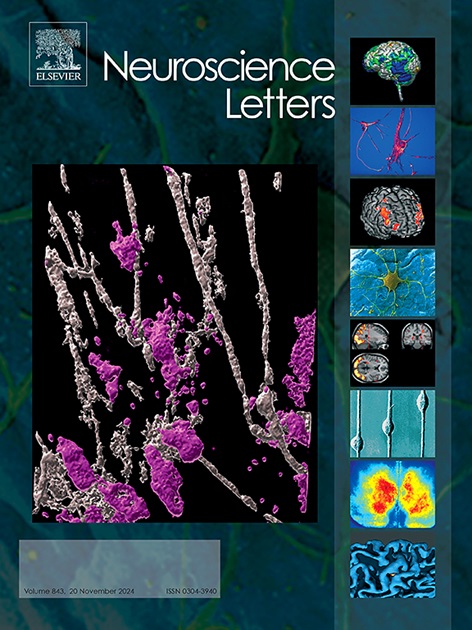Treatment with mesenchymal stem cells in a porcine model of sepsis: Assessment of the central nervous system
IF 2
4区 医学
Q3 NEUROSCIENCES
引用次数: 0
Abstract
Sepsis remains a leading cause of intensive care unit admissions and a significant public health challenge worldwide. Despite efforts, the development of specific therapies for sepsis has been limited. Mesenchymal stem cell therapy, particularly with cells derived from the human umbilical cord (hUC-MSC), has shown promise in animal studies. This study evaluated the use of hUC-MSC in a porcine model of sepsis induced by fecal peritonitis, focusing on hemodynamic and metabolic effects, inflammatory response, and central nervous system impact. Twenty-two pigs were randomized into a control group receiving fluids, vasopressors, and antibiotics, and a treatment group receiving the same interventions plus hUC-MSC infusion. Hemodynamic parameters, acid-base status, cytokine levels in serum and cerebrospinal fluid (CSF), and neuron-specific enolase were assessed over 24 h. Histopathological analysis of the hippocampus was performed post-mortem. No significant differences were observed between groups regarding hemodynamic and metabolic parameters or serum cytokine levels. While interleukin-1β levels in CSF increased in all animals’ post-sepsis induction, interleukin-10 levels were significantly higher in hUC-MSC-treated animals. Histopathological analysis revealed reduced congestion, vasodilation, and neuronal karyolysis in the hippocampus of the treatment group. These findings suggest that while hUC-MSC therapy does not significantly impact hemodynamics, metabolism, systemic inflammation, or mortality in septic shock, it may offer neuroprotective effects. Further studies are required to elucidate the mechanisms underlying these potential neuroprotective properties of hUC-MSC in sepsis.
用间充质干细胞治疗猪脓毒症模型:中枢神经系统的评估
脓毒症仍然是重症监护病房入院的主要原因,也是全球重大的公共卫生挑战。尽管做出了努力,但脓毒症特异性治疗的发展仍然有限。间充质干细胞治疗,特别是来自人脐带的细胞(hUC-MSC),在动物研究中显示出前景。本研究评估了hUC-MSC在猪粪性腹膜炎脓毒症模型中的应用,重点关注血流动力学和代谢作用、炎症反应和中枢神经系统影响。将22头猪随机分为对照组和治疗组,对照组给予液体、血管加压剂和抗生素治疗,治疗组给予相同的干预措施加hUC-MSC输注。在24小时内评估血液动力学参数、酸碱状态、血清和脑脊液(CSF)中的细胞因子水平以及神经元特异性烯醇化酶。死后进行海马组织病理学分析。在血液动力学和代谢参数或血清细胞因子水平方面,两组间无显著差异。虽然所有动物败血症诱导后脑脊液中白细胞介素-1β水平升高,但白细胞介素-10水平在huc - msc处理的动物中显著升高。组织病理学分析显示,治疗组海马充血、血管舒张和神经元核溶解减少。这些发现表明,尽管hUC-MSC治疗对感染性休克的血流动力学、代谢、全身炎症或死亡率没有显著影响,但它可能具有神经保护作用。需要进一步的研究来阐明hUC-MSC在败血症中这些潜在神经保护特性的机制。
本文章由计算机程序翻译,如有差异,请以英文原文为准。
求助全文
约1分钟内获得全文
求助全文
来源期刊

Neuroscience Letters
医学-神经科学
CiteScore
5.20
自引率
0.00%
发文量
408
审稿时长
50 days
期刊介绍:
Neuroscience Letters is devoted to the rapid publication of short, high-quality papers of interest to the broad community of neuroscientists. Only papers which will make a significant addition to the literature in the field will be published. Papers in all areas of neuroscience - molecular, cellular, developmental, systems, behavioral and cognitive, as well as computational - will be considered for publication. Submission of laboratory investigations that shed light on disease mechanisms is encouraged. Special Issues, edited by Guest Editors to cover new and rapidly-moving areas, will include invited mini-reviews. Occasional mini-reviews in especially timely areas will be considered for publication, without invitation, outside of Special Issues; these un-solicited mini-reviews can be submitted without invitation but must be of very high quality. Clinical studies will also be published if they provide new information about organization or actions of the nervous system, or provide new insights into the neurobiology of disease. NSL does not publish case reports.
 求助内容:
求助内容: 应助结果提醒方式:
应助结果提醒方式:


